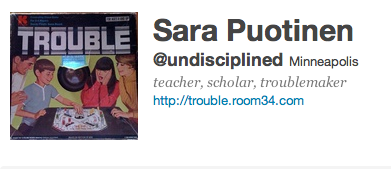I am always using this blog as a space for experimenting with new ways to archive my research (and to document who I am as a scholar, thinker, teacher, troublemaker). Sometimes these experiments work and sometimes they don’t. Here’s another one to add to the pile: Resources round-up. In this (type of) entry, I want to archive some resources (mostly articles, but some blogs) that I found and started reading this week. Hopefully, I can return to these resources later for future syllabi, articles, and/or blog entries. Perhaps if I become disciplined about it (ha ha! Even though I embrace being undisciplined, I still see value in developing specific sets of repeated practices–habits–on the blog. In fact, habitual writing is one thing that I really like about blogging.), I could do one of these resources round-ups every (other?) week? Possibly. But before I get ahead of myself, I need to write the first of these round-ups.
1. The Ethics of Waste
by Gay Hawkins
I have already started writing about this book on Unchained, a diablog that I started with my partner this summer (and haven’t written in since the beginning of August when the s**t hit the fan and I had to start working on multiple syllabi and finish up an article on feminist pedagogy and blogging). Originally I picked up this book in late August; I briefly thought about using it in my queering desire class in tandem with other sources on the abject. I imagine (but I can’t remember) that I was also intrigued by the author’s reading of waste through/in relation to ethics and daily practices. Now that I have read the introduction and first chapter, I am considering using it in my queer ethics class. Still not sure.
2.Developing a corporeal cyberfeminism: beyond cyberutopia
by Jessica E. Brophy
I haven’t read any of this article yet. Here’s the abstract:
This article discusses – and rejects – cyberutopia, an idealized theory of internet use that requires users to leave their bodies behind when online.The author instead calls for a cyberfeminist perspective in relation to studying the internet and other new media, centrally locating corporeality and embodiment. The underutilized concept of intra-agency is then employed to develop liminality in relation to the experience of going online.The author then outlines different versions of cyberfeminism and endorses that which addresses the relationships between the lived experiences of users and the technology itself.The article concludes with a call for theorists to expand and enrich the concepts used to study new media.
After a quick glance at the bibliography (which looks really helpful) and a skim through the article, I am convinced that this essay is a good one to revisit. The author hits on a lot of my areas of interest (including agency, Butler, performativity, liminality) and offers a good overview of cyberfeminism in relation to cybertopia.
3.DIGITAL WHITENESS, PRIMITIVE BLACKNESS: Racializing the “digital divide” in film and new media
by Janell Hobson
I am excited about this essay because of the author’s approach to thinking about the digital divide. While I recognize that access to technology (who has computers/who can get online) is a very important issue that needs to be addressed repeatedly, I worry about how “the digital divide” can be used to shut down any discussion about the transgressive and transformative potential of social media and Web 2.0 technology. I also worry about how discourses surrounding this divide work to reinforce certain binaries and ignore/erase experiences that don’t fit the binary–Hobson talks about this in relation to whiteness as progress/technological advancement and blackness as primitive. Here’s the abstract:
This essay argues that cultural scripts, such as popular films and other forms of visual culture, have constructed a racial ideology about technology, especially in conceptualizations of the “digital divide.” By associating whiteness with “progress,” “technology,” and “civilization,” while situating blackness within a discourse of “nature,” “primitivism,” and pre-modernity, the digital divide amasses cultural and racial weight and highlights hostile interactions with digital technology among marginal groups. However, a growing corpus of work by digital artists of color and web 2.0 participants has exposed these mythic constructions by re-imagining blackness and womanhood beyond technological exclusion and surveillance.
Here’s another excerpt in which Hobson provides a concrete overview of the essay:
In what remains, I first delve into the history of the technological divide between whiteness and blackness, as reflected in nineteenth- and early-twentieth-century world fairs and mid-twentieth-century films such as 2001: A Space Odyssey, prior to assessing contemporary themes of race and technological surveillance in the late-twentieth century science fiction films The Matrix and Strange Days. I then connect these cinematic representations to the work of black artists, such as Keith Piper, Julie Dash, and Damali Ayo, who underscore the black presence in the realm of digital technology. Finally, I conclude by ruminating on whether or not social “revolutions” for racial equality and inclusion can, in fact, be “digitized” (114).
I’m excited to read this essay; I imagine it will provide me with some useful ways for thinking beyond/outside of a narrow vision of the “digital divide.” Here’s one more passage that seems helpful in complicating the “digital divide”:
As these artistic models suggest, the “digital divide” is less about “access” and more about the technological dominance of a privileged few with global repercussions that threaten all of us, especially now that we have become so closely connected in the information superhighway. Marginalized groups, in particular, feel the impact of the high-tech age in profoundly personal and political ways. However, they are not just acted upon by technology; they have a creative and dynamic role in shaping our digital culture (122).
I really appreciate how Hobson envision agency here: marginalized groups are acted on by technology, but they also negotiate/resist/transform it.
Okay, these aren’t the only sources that I found this week. Because I am running out of energy and time, I will list a few more sources that I reviewed this week without any commentary:
4. Commentary and Criticism on Social Media and Intimacy
This commentary on Feminist Media Studies provides a series of mini-essays, including: “The New Architectures of Intimacy? Social networking sites and genders” by Usha Zacharias and Jane Arthurs and “This is not a Blog: Gender, intimacy, and community” by Catherine Driscoll.
5. The Digi-active Guide to Activism for Twitter and The Digi-active Guide to Activism for Facebook
In addition to these two guides, the Digi-active website is filled with information about digital activism, including this youtube video:
Also, check out their mission statement. I might use this in future classes. Maybe a class on digital activism–the possibilities and limits of thinking, acting and reflecting online (and, in tandem with offline)?









